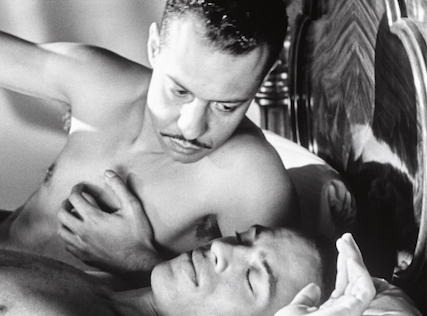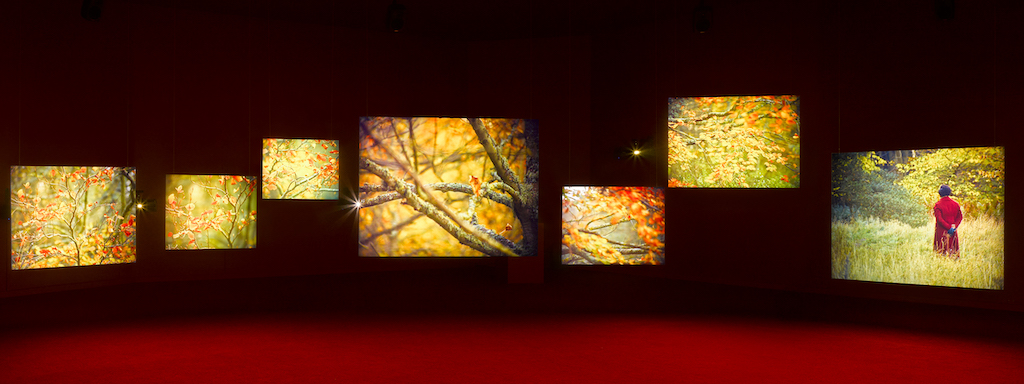Isaac Julien was a student at St Martin’s School of Art when the Brixton riots broke out. Black youths took to the streets, frustrated by high rates of unemployment, police harassment, far-right intimidation and media hostility, and all hell was let loose.
The following year, 21-year-old Colin Roach was shot at the entrance to Stoke Newington Police Station and this time Julien felt he had to respond. “I was determined,” he said, “to appropriate video art techniques and repurpose them for the street.” Made with Sankofa Film and Video Collective, Who Killed Colin Roach?, 1983 records the demonstrations that followed and the Roach family’s demand for a public enquiry.
The message of the film is crystal clear and the anger palpable, but Julien found the documentary format too restrictive. “I wanted to experiment, to create different visual auras, play with time… using factual material. My ultimate aim, really, was to create a style for political remembering.”
 Shot on super 8, then transferred to video and finally re-filmed on 16mm, Territories, 1984 is a montage of new footage and archive material of the Notting Hill Carnival. A black youth smiles to camera. His face acts as a filter behind which people parading in gorgeous costumes are intercut with footage of sound systems, police charges, arrests and rioting. And Joan Baez’ lyrics “Against us is the law… Against us is the power of police” establish a mood of fierce defiance. It’s a potent mix that is both visually and politically engaging.
Shot on super 8, then transferred to video and finally re-filmed on 16mm, Territories, 1984 is a montage of new footage and archive material of the Notting Hill Carnival. A black youth smiles to camera. His face acts as a filter behind which people parading in gorgeous costumes are intercut with footage of sound systems, police charges, arrests and rioting. And Joan Baez’ lyrics “Against us is the law… Against us is the power of police” establish a mood of fierce defiance. It’s a potent mix that is both visually and politically engaging.
Territories is on show at the entrance to Tate Britain’s survey of Julien’s work along with three other films from the 1980s, and the juxtaposition demonstrates the difficulty of exhibiting film and video. The soundtrack drowns out the voices of the interviewees in Who Killed Colin Roach? and effectively turns the documentary into wallpaper.
The main exhibition focuses on the multi-screen installations that Julien went on to develop and which, by their very nature, demand their own space. And working with architect David Adjaye, he has created an ingenious layout that provides each piece with a separate room.
On entry, you step into his latest work Once Again… (Statues Never Die), 2022 (main picture). Shot in black and white in the Barnes Foundation, Philadelphia and the Pitt Rivers Museum, Oxford (both collections of “tribal” art from Africa and elsewhere), this multi-screen installation is a maze of beautiful images.
Albert C Barnes and the vey dapper cultural theorist, Alain Locke (the first black Rhodes scholar at the Pitt Rivers) discuss the need to alter Western perceptions of African art as “primitive” and “exotic”. But the actors are voicing written texts, so this important debate is delivered in a series of stilted and wordy statements, more like parallel lectures than a dialogue. Added to the mix are extracts from You Hide Me, 1970 by Ghanaian film maker Nii Kwate Owoo, which argues for the repatriation of the Benin Bronzes, and Les Statues Meurent (Stautes Also Die), 1952 by Chris Marker and Alain Resnais. Black gay desire is also on the agenda in the form of extracts from Julien’s earlier work Looking for Langston, 1989 (pictured above right) – a work about Langston Hughes, poet and playwright of the Harlem Renaissance in the 1920s – and footage of Locke visiting a life class and admiring the sculptures of Richmond Barthé, with whom he is having a relationship.
Black gay desire is also on the agenda in the form of extracts from Julien’s earlier work Looking for Langston, 1989 (pictured above right) – a work about Langston Hughes, poet and playwright of the Harlem Renaissance in the 1920s – and footage of Locke visiting a life class and admiring the sculptures of Richmond Barthé, with whom he is having a relationship.
Confused? Me too. I can’t find a satisfactory way of responding to Isaac Julien’s installations. Trying to follow them rationally is frustrating because too much is happening at once. Regarding them as visual spectacle is more rewarding because of their beauty, but then you miss the points they are making. And since Julien’s work is fundamentally political, not to engage with the message seems like a cop out. “This gradual increase in scale – from one screen to two, to three, to five and so on,” he says, “has always been in service to ideas and theories.”
He started out making films “for the street”, but now he seems primarily to be addressing the museums that house his work. And obscurantism seems part of the plan. Shot in the John Soane Museum, Vagabondia, 2000, for instance, has a soundtrack in creole. “I was trying to explore a version of the repressed histories,” Julien explains. But unless you speak creole, those voices remain unheard.
In Lina Bo Bardi – A Marvellous Entanglement, 2019 the actors speak Portuguese, which is fine since the words of the Brazilian architect are accompanied by English subtitles. But the film is shot in seven of her buildings, none of which is identified; so you never know where you are and, although you hear a lot of her ideas, you learn very little about her buildings. Dancers (pictured above) move beautifully within them, which makes for great visuals but precious little by way of understanding. Lessons of the Hour, 2019 (pictured above: detail) avoids these problems by being far simpler in terms of subject matter and installation. Hung salon style, the screens are all visible at once. The subject is Frederick Douglass who escaped slavery in Maryland to become a writer, abolitionist and fearsome orator. Julien focuses on his visit to Britain in 1845 when he campaigned for the abolition of the slave trade.
Lessons of the Hour, 2019 (pictured above: detail) avoids these problems by being far simpler in terms of subject matter and installation. Hung salon style, the screens are all visible at once. The subject is Frederick Douglass who escaped slavery in Maryland to become a writer, abolitionist and fearsome orator. Julien focuses on his visit to Britain in 1845 when he campaigned for the abolition of the slave trade.
In impassioned speeches delivered to white audiences, he describes the United States as “a nation of savages” and the 4th of July celebrations as “a thin veil to cover up crimes.” He exposes his back lacerated by the whip and says, “I would if I could make visible the wounds of the system upon my soul.”
He invites us into a photography studio and in a "Lecture on Pictures” argues for the importance of the new medium in undermining racial stereotypes. The images are beautiful and the message is powerful. This time, there is no conflict between making art and making sense.
- Isaac Julien: What Freedom is to Me is at Tate Britain until 20th August
- More visual arts reviews on theartsdesk









![SEX MONEY RACE RELIGION [2016] by Gilbert and George. Installation shot of Gilbert & George 21ST CENTURY PICTURES Hayward Gallery](/sites/default/files/styles/thumbnail_125_x_125_/public/mastimages/Gilbert%20%26%20George_%2021ST%20CENTURY%20PICTURES.%20SEX%20MONEY%20RACE%20RELIGION%20%5B2016%5D.%20Photo_%20Mark%20Blower.%20Courtesy%20of%20the%20Gilbert%20%26%20George%20and%20the%20Hayward%20Gallery._0.jpg?itok=3oW-Y84i)





Add comment